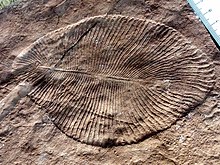




Megaevolution is a term which describes the most dramatic events in evolution. By that is not meant a different kind of evolution; rather, it means evolution which produces a tremendous effect. It is not suggested that the evolutionary processes involved are special although, in some cases they might be. Since the word 'macroevolution' can apply to relatively modest changes at the species and genus level, 'megaevolution' may be used for really huge changes.
The adaptive radiation of birds in the Lower Cretaceous, teleosts in the Cretaceous, flowering plants in the Upper Cretaceous, mammals in the Eocene, moths in the Cretaceous are striking examples of macroevolution. However, there are even more important events in the history of life. An interesting list was prepared by Maynard Smith and Szathmáry, which they called the major transitions in evolution. They did the list twice.[1][2]
- 1999 list
- Replicating molecules: change to populations of molecules in protocells
- Independent replicators leading to chromosomes
- RNA as gene and enzyme change to DNA genes and protein enzymes
- Bacterial cells (prokaryotes) leading to cells with nuclei and organelles (eukaryotes)
- Asexual clones leading to sexual populations
- Single-celled organisms leading to fungi, plants and animals
- Solitary individuals leading to colonies with non-reproducing castes (termites, ants & bees)
- Primate societies leading to human societies with language
Some of these topics have been discussed before.[3][4][5][6][7][8][9][10]
Numbers one to six on the list are about events which are of huge importance, but about which we know relatively little. All occurred before (and mostly very much before) the fossil record started, or at least before the Phanerozoic eon.
Numbers seven and eight on the list are of a different kind from the first six, and are generally not considered by the other authors. Number four is of a type which is not covered by traditional evolutionary theory, The origin of eukaryotic cells is probably due to symbiosis between prokaryotes. This is a kind of evolution which must be a rare event.[11][12][13]
- ↑ Maynard Smith J. & Szathmáry E. 1995. The major transitions in evolution. Oxford University Press, p6. ISBN 0-19-850294-X
- ↑ Maynard Smith J. & Szathmáry E. 1995. 1999. The origins of life: from the birth of life to the origins of language. Oxford University Press, p6. ISBN 0-19-286209-X
- ↑ Oparin A.I. 1952. The origin of life. New York: Dover.
- ↑ Penrose L.S. 1962. On living matter and self-replication. In J.B. Good (ed) The scientist speculates: an anthology of partly-baked ideas.
- ↑ Calvin, Melvin. 1969. Chemical evolution: molecular evolution towards the origin of living systems on the earth and elsewhere. Oxford University Press. ISBN 0198553420
- ↑ Cairns-Smith A.G. 1982. Genetic takeover and the mineral origins of life. Cambridge University Press. ISBN 0-521-23312-7
- ↑ Martin, William & Russel, Michael J. 2003. (2003). "On the origins of cells: a hypothesis for the evolutionary transitions from abiotic geochemistry to chemoautotrophic prokaryotes, and from prokaryotes to nucleated cells". Phil. Trans. R. Soc. B. 358 (1429): 59–85. doi:10.1098/rstb.2002.1183. PMC 1693102. PMID 12594918.
{{cite journal}}: CS1 maint: multiple names: authors list (link) CS1 maint: numeric names: authors list (link) - ↑ Hazen, Robert M. 2005. Genesis: the scientific quest for life's origins. Joseph Henry. ISBN 0-309-09432-1
- ↑ Cavalier-Smith, Thomas; Brasier, Martin and Embley, T. Martin (eds) 2006. Introduction: how and when did microbes change the world? Phil. Trans. R. Soc. B 361 845-850
- ↑ Leach, Sydney; Smith I.W.M. and Cockell, Charles S (eds) 2006. Introduction: conditions for the emergence of life on the early Earth. Phil. Trans. R. Soc. B 361 1675-1679. [1]
- ↑ Sapp J. 1994. Evolution by association: a history of symbiosis. Oxford University Press.
- ↑ Margulis, Lynn 1998. The symbiotic planet: a new look at evolution. Weidenfeld & Nicolson, London.
- ↑ Lake, James A. Evidence for an early prokaryote symbiogenesis. Nature 460 967–971.
